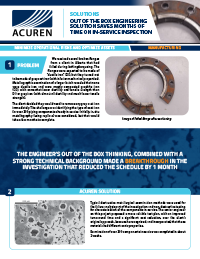- About
- Engineering
- Engineering Overview
- Field Engineering
- Field Engineering Overview
- Ferrite Testing
- Hardness Testing
- Metallurgical Replicas
- Optical Emission Spectroscopy (OES)
- Positive Material Identification (PMI)
- Materials Testing & Analysis
- Laboratory Services – Materials Testing & Analysis
- Sour Gas Corrosion Testing
- Materials Engineering
- Metallurgical Condition Assessment
- Steam Cycle Chemistry Services
- STRAP – Steam Turbine Risk Assessment Program
- Support for Industrial Insurers and Independent Adjusters
- Water Treatment Technologies Services
- Reliability Engineering
- Vibration Analysis
- Inspection
- Inspection Overview
- Advanced NDE/NDT
- Moisture Detection Imaging (MDI)
- Non-Intrusive/On Stream Inspection Program
- Phased Array Services
- Time of Flight Diffraction Technique (ToFD)
- NDE/NDT
- Visual Inspection (VT)
- National Board Program
- Drone & Robotic Inspection Services
- Inspection Training
- Rope Access Industrial Services
- Solutions
- Access Planner
- Ammonia Systems Inspection Services
- Asset Integrity Management / Mechanical Integrity
- Cathodic Protection Services
- Corrosion Under Insulation
- Drone & Robotic Inspection Services
- Facilities Piping Management Programs
- High Energy Piping Programs & Solutions
- Hydrogen Industry
- Laboratory Services – Materials Testing & Analysis
- Midstream Integrated Integrity Solutions
- National Board Program
- Non-Intrusive/On Stream Inspection Program
- PHMSA Mega Rule Solutions
- Research and Application Development
- Rope Access for CUPS
- Industries
- Industries Overview
- Aerospace
- Automobile
- Building & Infrastructure
- Chemical
- Food and Beverage
- Insurance & Litigation
- Manufacturing
- Metal Fabrication
- Mining
- Nuclear Power
- Oil & Gas
- Pipeline
- Pipeline Integrity Engineering Services
- Pipeline Integrity Field Services
- Power Generation
- Pulp & Paper
- Tanks
- Wind
Home Success Stories Solution Brief – Out of the Box Engineering Solution Saves Months of TimeSolution Brief – Out of the Box Engineering Solution Saves Months of Time
A unique solution saved months of time on this in-service inspection.
Problem

We received several broken flanges from a client in Redwater, Alberta that had failed during bolting/torqueing. The flanges were expected to be made of “ductile iron” (DI), but they turned out to be made of grey cast iron (with inferior mechanical properties). Metallographic examination of a larger batch revealed that none were ductile iron and were mostly compacted graphite iron (CGI; with somewhat lower ductility and tensile strength than DI) or grey iron (with almost nil ductility and much lower tensile strength). The client decided they would need to remove any grey cast iron immediately. The challenge was identifying the type of cast iron for over 200 piping components already in service.
Acuren Solution
Typical destructive metallurgical examination methods were used for the failure analysis part of the investigation and non-destructive testing for characterization of the components in service. The senior engineer on this project proposed a more reliable test plan, an improved turnaround time and a significant cost reduction over the client’s original approach, because he recognized, and incorporated, that these materials had different sonic properties.
Examination of over 200 components in service was completed in about 2 weeks.
The engineer’s out of the box thinking, combined with a strong technical background made a break-through in the investigation that reduced the schedule by 1 month.
Technical

Initially, in-situ metallography (using replicas) was considered, but that would take a few months to complete. An ultrasonic velocity test was chosen to sort out the components.
Grey iron has a characteristically low sound traveling velocity (approx. 3500 m/s) due to the abundance of large overlapping graphite flakes. DI and CGI, on the other hand, exhibits a much higher velocity (approx. 5000-6000 m/s) due to a free path of travel between graphite particles.
Another advantage of the ultrasonic test over an in-situ metallography was its higher accuracy and reliability. The velocity test samples the material through a large thickness, while replication examines the microstructure at the surface, which can be very different from that at the core or across the thickness for a casting.
Credentials
• Professional Engineer
• UT TechnicanDamage Mechanism
• Instantaneous (overload) fractures upon bolting/torqueingValue
Acuren engineers and technicians have unparalelled education and field experience which, when combined, enables productivity solutions otherwise not possible. With the proposal of using a special type of non-destructive testing (UT instead of replicas) the second part of the investigation took approximnately 2 weeks instead of the originally estimated 1-2 months.
Engineers, field technicians and NDT experts collaborated to find a suitable technique based on the engineer’s unique idea which saved time, cost and increased reliability.
Acuren provides state-of-the-art nondestructive testing, inspection, engineering and rope access enabled integrated services, delivered throughout 110+ locations and utilizing 5,500 employees across North America and the United Kingdom.
To speak to our team about this project or to find out how we can help solve your complex challenges, please call 1-800-218-7450 or email us.
Access the PDF for this project by clicking on the image:

